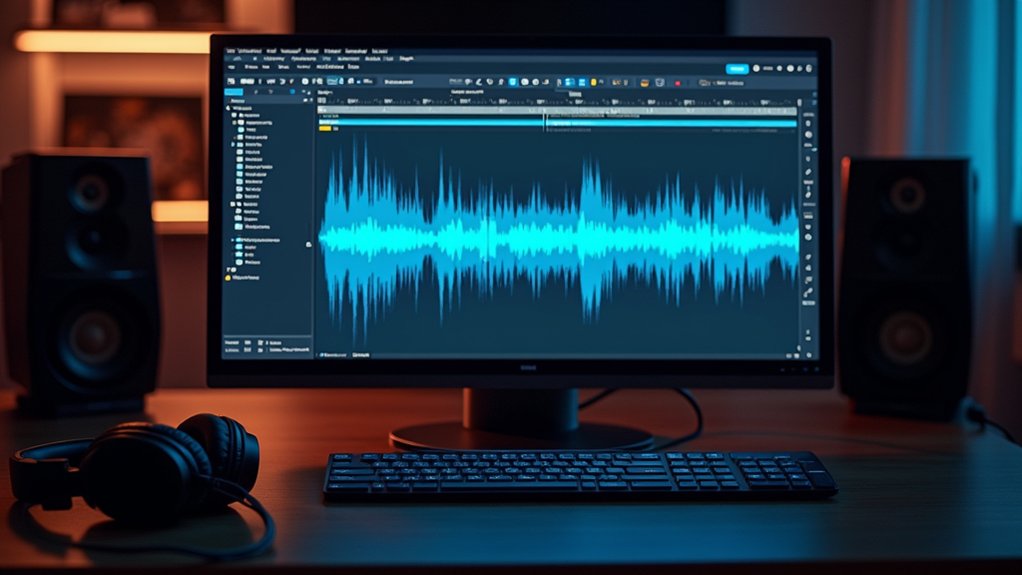In Audacity, a low-pass filter enables users to attenuate high-frequency content, creating a smooth high-end roll-off. Users can select the Low Pass Filter from the Effect menu, set the cutoff frequency (e.g., 5–8 kHz for vocals), and adjust the roll-off slope in decibels per octave for precise control. Previewing changes guarantees audio clarity and warmth are maintained. Further guidance addresses selecting filter parameters, adjusting tonal balance, and troubleshooting for ideal results.
Key Takeaways
- Open the “Effect” menu in Audacity, select “Low Pass Filter,” and choose your desired audio region to process.
- Set the cutoff frequency to target unwanted high frequencies while preserving clarity and warmth in your audio.
- Use a gentle roll-off slope (such as 6 dB per octave) to achieve a smooth and natural high-end attenuation.
- Preview filter settings before applying to ensure tonal balance and avoid dullness or muddiness in your mix.
- Incrementally adjust cutoff and roll-off parameters for fine-tuning, maintaining musicality and avoiding harsh transitions.
Understanding Low-Pass Filters and Their Role in Audio Processing
How do low-pass filters influence audio processing workflows? A low-pass filter serves a fundamental role by allowing frequencies below a defined cutoff frequency to pass while it attenuates frequencies above this threshold.
This selective frequency reduction is vital when managing high frequencies that may introduce harshness or undesirable noise in an audio mix. The roll-off rate determines how sharply the filter attenuates frequencies beyond the cutoff, directly impacting the degree of high-end roll-off achieved.
Engineers may select from designs such as Butterworth, which offers a flat frequency response, or Chebyshev, which introduces passband ripples for specialized effects.
Key Parameters: Cutoff Frequency and Roll-Off Explained
When configuring a low-pass filter in Audacity, two primary parameters require attention: cutoff frequency and roll-off slope.
The cutoff frequency specifies the threshold where high-frequency attenuation begins, while the roll-off slope determines how rapidly this attenuation occurs beyond that point.
Accurate adjustment of these settings is essential for achieving the intended balance between filtered and preserved audio frequencies.
Understanding Cutoff Frequency
Although low-pass filters are common tools in audio editing, their effectiveness depends on two key parameters: cutoff frequency and roll-off.
The cutoff frequency defines the precise point where a low-pass filter begins to attenuate incoming frequencies, specifically set where the signal is reduced by 3 dB. Frequencies below this threshold remain largely unaffected, while those above experience increasing attenuation.
In practical terms, the selection of an appropriate cutoff frequency is essential for controlling which high-end content is reduced in the audio signal. Adjustment of this parameter allows the user to tailor the filter’s impact, ensuring that valuable frequencies are preserved and unwanted noise or harshness is minimized.
Accurate cutoff frequency placement is fundamental for shaping timbre and achieving clarity in mixing and production workflows.
Defining Roll-Off Slope
Roll-off slope serves as a critical parameter in the configuration of low-pass filters within Audacity, quantifying the rate at which high-frequency content is attenuated beyond the designated cutoff frequency.
Measured in decibels per octave, the roll-off slope determines how abruptly high frequencies are reduced after crossing the cutoff frequency. A gentle roll-off slope (e.g., 6 dB per octave) results in a smoother, less aggressive attenuation, while a steeper slope (e.g., 12 dB per octave) enforces more immediate reduction of unwanted high frequencies.
The interaction between cutoff frequency and roll-off slope is essential for controlling tonal quality and clarity. Selecting the right parameters guarantees effective filtering and preserves the desired audio character.
- Precise control over tonal quality
- Enhanced focus on intended frequency range
- Prevention of harsh high-frequency artifacts
- Customizable attenuation to meet project needs
Step-by-Step Guide to Applying a Low-Pass Filter in Audacity
Applying a low-pass filter in Audacity requires a systematic approach to guarantee ideal audio processing.
To begin, select the audio region to be processed. Navigate to the “Effect” menu and choose “Low Pass Filter” from the dropdown options.
In the dialog box, set the desired cutoff frequency, which defines the upper limit of the frequency content allowed to pass through. The default value is 160 Hz, but this can be adjusted from 20 Hz to 20 kHz according to project requirements.
Next, configure the roll-off steepness, typically measured in decibels per octave, to control how aggressively the filter attenuates frequencies above the cutoff.
Utilize the preview function to audition the effect, then apply this effect to finalize the smoothing of high-end frequencies.
Choosing the Right Cutoff Frequency for Smoother Sound
Selecting the ideal cutoff frequency requires careful assessment of the audio material to retain clarity while introducing desired warmth. Users should incrementally adjust the cutoff point, monitoring for a balance between reduced high-frequency harshness and preserved intelligibility. Employing critical listening at each stage guarantees that the processing enhances smoothness without sacrificing essential detail. To achieve professional-sounding audio, mastering the use of EQ in Audacity is crucial for manipulating specific sound frequencies effectively.
Identifying Optimal Cutoff Point
How does one determine the most effective cutoff frequency for a low-pass filter in Audacity? The process begins by analyzing the audio’s content and identifying which high frequencies should be attenuated to achieve the intended tonal balance.
The cutoff frequency acts as the threshold: frequencies above this point are gradually reduced, while those below remain prominent within the frequency band. Selection should be based on the material—vocals often benefit from a cutoff around 5–8 kHz, whereas sub-bass may require settings as low as 160 Hz.
Experimentation is essential for ideal results.
- Evaluate the audio source and desired tonal balance.
- Set the cutoff frequency to target problematic high frequencies.
- Apply the low-pass filter and monitor the effect.
- Fine-tune by incrementally adjusting the cutoff frequency.
Balancing Clarity and Warmth
Once the ideal cutoff point has been identified, attention shifts to fine-tuning the balance between clarity and warmth in the audio.
In Audacity, applying a low-pass filter requires precise selection of the cutoff frequency; values between 160 Hz and 2560 Hz often yield a smoother high-end roll-off. For vocal tracks, setting the cutoff frequency near 5 kHz is effective for reducing sibilance while preserving essential clarity and warmth.
Employing a gentle slope, such as 6 dB per octave, guarantees high frequencies are attenuated gradually, maintaining a natural tonal balance. Critical listening is vital; adjust the cutoff frequency while monitoring for muddiness or loss of detail.
Experimentation with LFO modulation on the cutoff frequency can further enhance dynamic warmth and presence during playback.
Adjusting Roll-Off for Effective High-End Attenuation
Fine-tuning the roll-off parameter in Audacity’s low-pass filter directly influences how sharply high-frequency content is reduced beyond the cutoff point. The frequency setting establishes the threshold at which attenuation begins, while the roll-off value, measured in decibels per octave, dictates the rate at which high frequencies are diminished.
Selecting an appropriate roll-off is vital: a gentle 6 dB per octave slope provides subtle control, while steeper 12 dB or 24 dB values yield more aggressive attenuation, essential for managing harshness or unwanted brightness. Users should monitor sound quality as adjustments are made, continuously A/B testing to guarantee clarity and tonal integrity.
- Achieve targeted high-frequency reduction without sacrificing musicality.
- Prevent excessive dullness by monitoring filter impact in real time.
- Balance warmth and definition for peak sound quality.
- Experience increased control and precision in audio processing.
Creative Applications for Low-Pass Filters in Mixing and Sound Design
Expand sonic possibilities through utilizing low-pass filters as creative tools within mixing and sound design workflows. Low-pass filters allow engineers to precisely attenuate high frequency content, softening vocals or blending percussive elements for cohesion. To apply an effect, determine the frequency must fall below the track sample rate’s Nyquist limit. Automate cutoff frequency for dynamic shifts, injecting movement and anticipation into the arrangement. Combine low-pass filters with LFO modulation to generate rhythmic pulsations, enriching the sonic texture. In dense mixes, LPFs can carve space, reducing frequency overlap and enhancing separation of instruments. The following table illustrates creative applications:
| Application | Resulting Effect |
|---|---|
| Automated cutoff shifts | Dynamic builds/drops |
| Resonant filtering on percussion | Textured, cohesive rhythm |
| LFO-modulated low-pass | Pulsating, energetic movement |
| Reducing overlap in dense mixes | Improved clarity and separation |
Tips for Achieving Warm and Mellow Audio With Low-Pass Filtering
Achieving a warm and mellow audio character with low-pass filtering in Audacity involves careful adjustment of filter parameters to eliminate excessive high-frequency content while retaining low-end richness.
Begin by applying a low-pass filter with a cutoff frequency set between 160 Hz and 2560 Hz—this range typically removes harshness without sacrificing fullness. Select a gentle roll-off, such as 6 dB per octave, to guarantee smooth spectral shifts.
Maintain a low resonance (Q) setting, ideally between 0.1 and 1.0, to prevent unwanted peaks. For dynamic tonal control, automate the cutoff frequency during quieter or more energetic sections.
- Fine-tune cutoff frequency for subtle warmth.
- Employ a gentle roll-off for natural blending.
- Minimize resonance to avoid artifacts.
- Apply automation for expressive tonal shifts.
Troubleshooting Common Issues When Using Low-Pass Filters in Audacity
When configuring a low-pass filter in Audacity, improper parameter selection can introduce issues such as excessive dullness, loss of clarity, or unintended muddiness in the audio.
To mitigate these problems, set the cutoff frequency within an appropriate range—typically between 20 Hz and 20 kHz—ensuring unwanted high frequencies are reduced without compromising overall brightness.
Adjust the roll-off slope judiciously; a steeper slope (e.g., 12 dB per octave) provides stronger attenuation of high frequencies but may lead to tonal imbalance or excessive filtering.
Always use the preview feature to assess real-time changes and verify audio integrity before applying adjustments.
If the outcome results in a muddy or low frequency-heavy mix, revisit both cutoff frequency and roll-off slope parameters, and incrementally refine settings to preserve clarity.
Frequently Asked Questions
What Does a Low-Pass Filter Do in Audacity?
A low-pass filter in Audacity functions as an audio processing tool, modifying frequency response by attenuating high frequencies. Its filter characteristics and applications are essential in sound design, allowing precise control over spectral content and mix clarity.
What Is Roll-Off in a Low-Pass Filter?
Roll-off in a low-pass filter defines the rate at which audio frequency components are attenuated beyond the cutoff point. This filter characteristic, determined by filter design, directly impacts signal processing and resultant sound quality in audio workflows.
What Should My Low-Pass Filter Be Set To?
When determining filter frequency settings, users should start between 160 Hz and 2560 Hz for general audio quality improvement. Sound design techniques recommend filter slope adjustments, typically 12 dB per octave, and mixing tips strategies involve attentive listening and context-based decisions.
How to Calculate Roll-Off of a Filter?
To calculate roll-off in filter design, one measures the decibel reduction per octave above the cutoff frequency, determined by the filter order. In audio applications and signal processing, this quantifies how rapidly unwanted frequencies are attenuated.
Conclusion
Applying a low-pass filter in Audacity enables precise control over high-frequency content, facilitating smoother audio textures and targeted attenuation. By selecting an appropriate cutoff frequency and adjusting the roll-off slope, users can effectively tailor the tonal balance of their tracks. Mastery of low-pass filtering techniques enhances both corrective and creative audio processing, ensuring professional results. Consistent evaluation and fine-tuning of filter parameters are essential for achieving desired warmth, clarity, and sonic character in any project.




